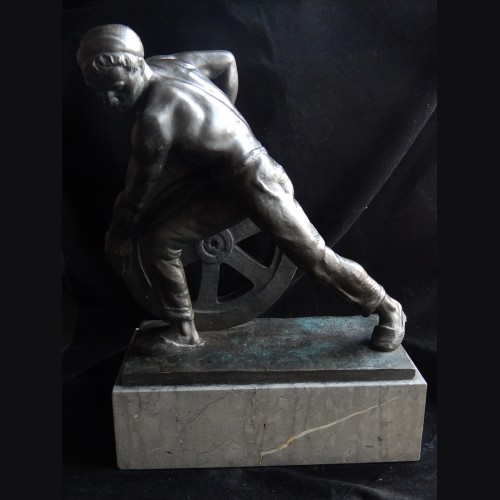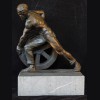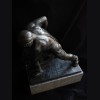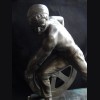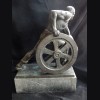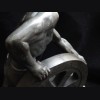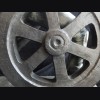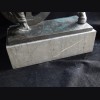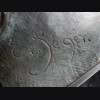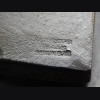Arbeiter mit Rad- Ernst Seger # 3368
Large and powerful bronze on marble sculpture by noted German sculptor Ernst Seger depicting a a bare chested foundry worker pushing a large wheel and dating from about 1936.
This bronze measures 15 1/2" tall overall and is about 12" across. It is in excellent condition, retaining all of its original dark brown patina. It is mounted to its original grey variegated marble base, which is in excellent condition. The sculpture weighs 42 lbs (!) Signed in the bronze E. Seger and stamped with the foundry mark: Bildgiesserei Krass Berlin S42.
Seger's neoclassical style found favor with the National Socialists. He received commissions for portrait busts of Hitler and Goering, and exhibited in the Grosse Deutsche Kunstaustellung in Munich until his death in 1939 at 70 years old. Below is some biographical information Seger.
Ernst Seger (1868-1939) was born in Neurode (Nowa Ruda, now Poland), studied sculpturing from 1884 at the Kunstschule in Breslau under Robert Härtel. From 1886 he worked in the Atelier of Christian Behrens, where he created the Eichendorff-Memorial for the Silezian City of Neisse. From 1893 to 1894 Seger stayed in Paris where he worked in the atelier of Auguste Rodin. However, Seger finally chose a ‘Jugendstil’ and a more ‘naturalistic’ or ‘Neuklassizismus’ style. His sculptures, modelled like the Greek antiques, were later greatly admired by the National Socialists. At the end of 1894 Ernst Seger went back to Berlin, founded his own atelier and created the Kaiser Wilhelm I memorial for the Silesian City of Glatz. In 1897 Seger created the sculpture ‘Jugend’ (‘Youth’), which was displayed at the ‘Große Berliner Kunstausstellung’ in 1898, at the ‘Große Berliner Kunstausstellung’ in 1899, at the ‘Münchener Glaspalast Ausstellung’ in 1899 and at the ‘Münchener Glaspalast Ausstellung’ in 1908. As a sculptor Seger regarded this as his first relevant work, his breakthrough. A copy of the sculpture in bronze, 1.60 metres high, was placed in the ‘Scheitniger Park’ in Breslau (now Wroclaw). In 1898 Segers ‘Diana’, the Roman Goddess of the Hunt, the Moon and Childbirth, was unvealed in Park Szczytnicki, Breslau, Polen (earlier ‘Schneitniger Park’). Until 1945 the sculpture stayed in the Schneitniger Park, Breslau. This part of the park is still called ’Dianagarten’.
After the turn of the century the elegant female dancers and nudes by Seger gained great popularity. In 1905 Ernst Seger created -together with the sculptor Bernhard Sehring- the ‘Bismarck Brunnen’ (‘Bismarck Fountain’) in Breslau. This memorial-fountain (which still exists) represents the allegories ‘Kampf’ and ‘Sieg’ (‘Battle and Victory’). Seger’s ‘Verwundete Amazone’ (‘Wounded Amazon’), displayed at the Grosse Münchner Kunstausstellung in the Glaspalast in 1908, was placed in the garden of the ‘Kaufhauses Wertheim’ in Berlin. In the same year he was appointed as a professor. Seger’s marble sculpture ‘Kypris’, created in 1916, was placed in the Alten Nationalgalerie in Berlin. In 1925 the City of Berlin acquired his sculpture ‘Anbetung’ and placed it at the Johannaplatz. ‘Storchenbrunnen’ (‘Stork-fountain’), was placed in 1931 at the Adolf-Scheidt-Platz in Berlin. In 1935 the American newspaper publisher William Randolph Hearst bought Seger’s sleeping ‘Ganymede’.
During the Third Reich Ernst Seger was commissioned numerous Hitler busts; in 1933 one of them was placed in the hall of honour at the ‘Internationale Funkausstellung’(‘German Radio Exposition’) in Berlin. At the turn of the year 1933/1934 he created a relief of ‘Hindenburg and Hitler’. Despite Segers popularity and fame his life-size ‘Am Ziel’ ('At the Finish') which had stood at the edge of the Berlin Wannsee since 1934, was melted down in 1940, as bronze was needed for the war-industry (‘Am Ziel', 190 cm high, was displayed for the first time at the exhibition 'Hundert Jahre Berliner Kunst', 1929, organized by the Verein Berliner Künstler).
At the Great German Art Exhibitions Seger was, until his death in 1939, represented with seven sculptures, including ‘Sportlerin’. Adolf Hitler bought ‘Lebenskraft’ (‘Vitality’) for 15,000 RM, as well as 'Gewichtheber’ (‘Weightlifter’) and ‘Kraftgefühl’ (‘Feeling of Power’).
Ernst Seger died in August 1939 in Berlin. Seger’s gravestone at the Südwestkirchhof Stahnsdorf bears his marble relief ‘Der Bildhouwer und sein Gedanken’, which was displayed at the Grosse Berliner Kunstausstellung 1921.
In October 2015 a copy of Segers sculpture Diana (d.d. 1898) was placed on exact the same location: Park Szczytnicki, Wroclau, Polen, earlier ‘Schneitniger Park, Breslau’ (the stone base is still original).
REFERENCE ONLY. (SOLD or NOT FOR SALE)
Large and powerful bronze on marble sculpture by noted German sculptor Ernst Seger depicting a a bare chested foundry worker pushing a large wheel and dating from about 1936.
This bronze measures 15 1/2" tall overall and is about 12" across. It is in excellent condition, retaining all of its original dark brown patina. It is mounted to its original grey variegated marble base, which is in excellent condition. The sculpture weighs 42 lbs (!) Signed in the bronze E. Seger and stamped with the foundry mark: Bildgiesserei Krass Berlin S42.
Seger's neoclassical style found favor with the National Socialists. He received commissions for portrait busts of Hitler and Goering, and exhibited in the Grosse Deutsche Kunstaustellung in Munich until his death in 1939 at 70 years old. Below is some biographical information Seger.
Ernst Seger (1868-1939) was born in Neurode (Nowa Ruda, now Poland), studied sculpturing from 1884 at the Kunstschule in Breslau under Robert Härtel. From 1886 he worked in the Atelier of Christian Behrens, where he created the Eichendorff-Memorial for the Silezian City of Neisse. From 1893 to 1894 Seger stayed in Paris where he worked in the atelier of Auguste Rodin. However, Seger finally chose a ‘Jugendstil’ and a more ‘naturalistic’ or ‘Neuklassizismus’ style. His sculptures, modelled like the Greek antiques, were later greatly admired by the National Socialists. At the end of 1894 Ernst Seger went back to Berlin, founded his own atelier and created the Kaiser Wilhelm I memorial for the Silesian City of Glatz. In 1897 Seger created the sculpture ‘Jugend’ (‘Youth’), which was displayed at the ‘Große Berliner Kunstausstellung’ in 1898, at the ‘Große Berliner Kunstausstellung’ in 1899, at the ‘Münchener Glaspalast Ausstellung’ in 1899 and at the ‘Münchener Glaspalast Ausstellung’ in 1908. As a sculptor Seger regarded this as his first relevant work, his breakthrough. A copy of the sculpture in bronze, 1.60 metres high, was placed in the ‘Scheitniger Park’ in Breslau (now Wroclaw). In 1898 Segers ‘Diana’, the Roman Goddess of the Hunt, the Moon and Childbirth, was unvealed in Park Szczytnicki, Breslau, Polen (earlier ‘Schneitniger Park’). Until 1945 the sculpture stayed in the Schneitniger Park, Breslau. This part of the park is still called ’Dianagarten’.
After the turn of the century the elegant female dancers and nudes by Seger gained great popularity. In 1905 Ernst Seger created -together with the sculptor Bernhard Sehring- the ‘Bismarck Brunnen’ (‘Bismarck Fountain’) in Breslau. This memorial-fountain (which still exists) represents the allegories ‘Kampf’ and ‘Sieg’ (‘Battle and Victory’). Seger’s ‘Verwundete Amazone’ (‘Wounded Amazon’), displayed at the Grosse Münchner Kunstausstellung in the Glaspalast in 1908, was placed in the garden of the ‘Kaufhauses Wertheim’ in Berlin. In the same year he was appointed as a professor. Seger’s marble sculpture ‘Kypris’, created in 1916, was placed in the Alten Nationalgalerie in Berlin. In 1925 the City of Berlin acquired his sculpture ‘Anbetung’ and placed it at the Johannaplatz. ‘Storchenbrunnen’ (‘Stork-fountain’), was placed in 1931 at the Adolf-Scheidt-Platz in Berlin. In 1935 the American newspaper publisher William Randolph Hearst bought Seger’s sleeping ‘Ganymede’.
During the Third Reich Ernst Seger was commissioned numerous Hitler busts; in 1933 one of them was placed in the hall of honour at the ‘Internationale Funkausstellung’(‘German Radio Exposition’) in Berlin. At the turn of the year 1933/1934 he created a relief of ‘Hindenburg and Hitler’. Despite Segers popularity and fame his life-size ‘Am Ziel’ ('At the Finish') which had stood at the edge of the Berlin Wannsee since 1934, was melted down in 1940, as bronze was needed for the war-industry (‘Am Ziel', 190 cm high, was displayed for the first time at the exhibition 'Hundert Jahre Berliner Kunst', 1929, organized by the Verein Berliner Künstler).
At the Great German Art Exhibitions Seger was, until his death in 1939, represented with seven sculptures, including ‘Sportlerin’. Adolf Hitler bought ‘Lebenskraft’ (‘Vitality’) for 15,000 RM, as well as 'Gewichtheber’ (‘Weightlifter’) and ‘Kraftgefühl’ (‘Feeling of Power’).
Ernst Seger died in August 1939 in Berlin. Seger’s gravestone at the Südwestkirchhof Stahnsdorf bears his marble relief ‘Der Bildhouwer und sein Gedanken’, which was displayed at the Grosse Berliner Kunstausstellung 1921.
In October 2015 a copy of Segers sculpture Diana (d.d. 1898) was placed on exact the same location: Park Szczytnicki, Wroclau, Polen, earlier ‘Schneitniger Park, Breslau’ (the stone base is still original).


